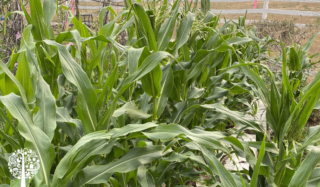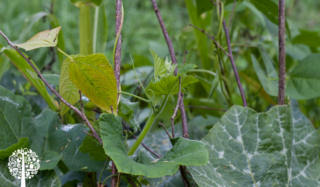The veggie patch bursts with late summer and fall harvests, often including corn, beans, and squash. These crops are called the Three Sisters, and planting them together is a tried-and-true gardening method that has proven successful for over millennia.

History
The Three Sisters growing method was once widely used by Indigenous communities throughout North and South America.
The Haudenosaunee people of North America comprise the Mohawk, Onondaga, Oneida, Cayuga, Seneca, and Tuscarora. They explain that when the daughter of the Original Woman passed on, she was buried in “new earth,” and from that spot, three sisters emerged. One was tall with golden hair and wore a green shawl, and another wore a yellow dress. The third sister was in green and crawled on the ground. They encouraged each other to flourish; the golden-haired corn, green beans, and yellow squash.
Growing Together
Traditionally, corn is planted in mounded rows or circles 1.2 meters apart. Once the stalks are 25-30cm high, four or five bean seeds are evenly sown in a circle 60cm in diameter around each.
Patience matters. Getting excited and planting the beans too early (before the corn stalks are high enough) will pull them down and hamper their growth.
Once the beans have sprouted, plant the squash in the spaces between the corn or around the mound’s perimeter. The squash can be butternut, pumpkin, or zucchini.
Helping Hands

The growing corn stalk acts as a trellis for the climbing beans, stabilizing the corn in case of strong wind or rain. The squash leaves keep the soil cool and moist by blocking the hot evaporating rays of the sun. Its traditionally prickly leaves keep out animals and insects, like slugs and snails.
Nourishing The Soil
Plants take different things from the soil, and often growers rotate their crops to ensure the soil never gets too depleted of nutrients.
The same plot can be planted repeatedly in a Three Sisters garden because each plant builds and nourishes the soil. Beans have bacteria living on their roots that absorb nitrogen from the air. Corn requires a lot of nitrogen to grow. It’s a continuous cycle of reciprocity that doesn’t deplete the soil of nutrients.
Supplying Nutritional Needs
A Three Sisters diet is a healthy choice! Corn is rich in carbohydrates, beans contain protein, and squash is high in vitamin A. Together, corn and beans provide all ten of the essential amino acids our bodies need.
Agriculture and Agri-Food Canada sponsored the Three Sisters project, which has helped researchers and Indigenous community members better understand the nutritional benefits of a diet that includes corn, bean, and squash.
The project also strives to reconnect lost ancestral food traditions of healthy eating to the communities that discovered them. We all must get a broader understanding of sustainable growing methods once used to preserve biodiversity and reintroduce them to our modern growing habits.